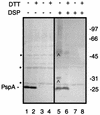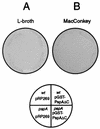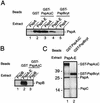Interactions between phage-shock proteins in Escherichia coli
- PMID: 12562786
- PMCID: PMC142853
- DOI: 10.1128/JB.185.4.1174-1180.2003
Interactions between phage-shock proteins in Escherichia coli
Abstract
Expression of the pspABCDE operon of Escherichia coli is induced upon infection by filamentous phage and by many other stress conditions, including defects in protein export. Expression of the operon requires the alternative sigma factor sigma54 and the transcriptional activator PspF. In addition, PspA plays a negative regulatory role, and the integral-membrane proteins PspB and PspC play a positive one. In this study, we investigated whether the suggested protein-protein interactions implicated in this complex regulatory network can indeed be demonstrated. Antisera were raised against PspB, PspC, and PspD, which revealed, in Western blotting experiments, that PspC forms stable sodium dodecyl sulfate-resistant dimers and that the hypothetical pspD gene is indeed expressed in vivo. Fractionation experiments showed that PspD localizes as a peripherally bound inner membrane protein. Cross-linking studies with intact cells revealed specific interactions of PspA with PspB and PspC, but not with PspD. Furthermore, affinity-chromatography suggested that PspB could bind PspA only in the presence of PspC. These data indicate that regulation of the psp operon is mediated via protein-protein interactions.
Figures






Similar articles
-
Stress-induced expression of the Escherichia coli phage shock protein operon is dependent on sigma 54 and modulated by positive and negative feedback mechanisms.Genes Dev. 1991 Oct;5(10):1912-23. doi: 10.1101/gad.5.10.1912. Genes Dev. 1991. PMID: 1717346
-
Identification of a new member of the phage shock protein response in Escherichia coli, the phage shock protein G (PspG).J Biol Chem. 2004 Dec 31;279(53):55707-14. doi: 10.1074/jbc.M408994200. Epub 2004 Oct 13. J Biol Chem. 2004. PMID: 15485810
-
Properties of the phage-shock-protein (Psp) regulatory complex that govern signal transduction and induction of the Psp response in Escherichia coli.Microbiology (Reading). 2010 Oct;156(Pt 10):2920-2932. doi: 10.1099/mic.0.040055-0. Epub 2010 Jul 1. Microbiology (Reading). 2010. PMID: 20595257 Free PMC article.
-
Recent findings about the Yersinia enterocolitica phage shock protein response.J Microbiol. 2012 Feb;50(1):1-7. doi: 10.1007/s12275-012-1578-7. Epub 2012 Feb 27. J Microbiol. 2012. PMID: 22367931 Free PMC article. Review.
-
The Escherichia coli phage-shock-protein (psp) operon.Mol Microbiol. 1997 Apr;24(2):255-61. doi: 10.1046/j.1365-2958.1997.3481712.x. Mol Microbiol. 1997. PMID: 9159513 Review.
Cited by
-
The first α-helical domain of the vesicle-inducing protein in plastids 1 promotes oligomerization and lipid binding.Planta. 2013 Feb;237(2):529-40. doi: 10.1007/s00425-012-1772-1. Epub 2012 Oct 2. Planta. 2013. PMID: 23053543
-
Secretion defects that activate the phage shock response of Escherichia coli.J Bacteriol. 2003 Nov;185(22):6707-11. doi: 10.1128/JB.185.22.6707-6711.2003. J Bacteriol. 2003. PMID: 14594846 Free PMC article.
-
The Yersinia enterocolitica phage shock proteins B and C can form homodimers and heterodimers in vivo with the possibility of close association between multiple domains.J Bacteriol. 2011 Oct;193(20):5747-58. doi: 10.1128/JB.05080-11. Epub 2011 Aug 19. J Bacteriol. 2011. PMID: 21856846 Free PMC article.
-
Genome-wide bioinformatic prediction and experimental evaluation of potential RNA thermometers.Mol Genet Genomics. 2007 Nov;278(5):555-64. doi: 10.1007/s00438-007-0272-7. Epub 2007 Jul 24. Mol Genet Genomics. 2007. PMID: 17647020
-
Characterization of the Streptomyces lividans PspA response.J Bacteriol. 2008 May;190(10):3475-81. doi: 10.1128/JB.01966-07. Epub 2008 Mar 7. J Bacteriol. 2008. PMID: 18326578 Free PMC article.
References
-
- Adams, H., W. Teertstra, M. Koster, and J. Tommassen. 2002. PspE (phage-shock protein E) of Escherichia coli is a rhodanese. FEBS Lett. 518:173-176. - PubMed
-
- Agterberg, M., H. Adriaanse, A. van Bruggen, M. Karperien, and J. Tommassen. 1990. Outer-membrane PhoE protein of Escherichia coli K-12 as an exposure vector: possibilities and limitations. Gene 88:37-45. - PubMed
-
- Akrim, M., M. Bally, G. Ball, J. Tommassen, H. Teerink, A. Filloux, and A. Lazdunski. 1993. Xcp-mediated protein secretion in Pseudomonas aeruginosa: identification of two additional genes and evidence for regulation of xcp gene expression. Mol. Microbiol. 10:431-443. - PubMed
-
- Ansorge, W. 1985. Fast and sensitive detection of protein and DNA bands by treatment with potassium permanganate. J. Biochem. Biophys. Methods 11:13-20. - PubMed
-
- Bauer, M. F., C. Sirrenberg, W. Neupert, and M. Brunner. 1996. Role of Tim23 as voltage sensor and presequence receptor in protein import into mitochondria. Cell 87:33-41. - PubMed
Publication types
MeSH terms
Substances
LinkOut - more resources
Full Text Sources
Molecular Biology Databases
Miscellaneous

